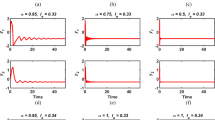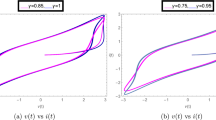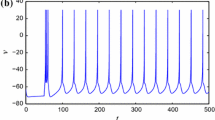Abstract
This work focuses on the practical and reasonable synthesis of the fractional-order FitzHugh-Nagumo (FHN) neuronal model. First of all, the descriptive equations of the fractional FHN neuronal system have been given, and then the system stability has been analyzed according to these equations. Secondly, the Laplace-Adomian-decomposition-method is introduced for the numerical solution of the fractional-order FHN neuron model. By means of this method, rapid convergence can be achieved as well as advantages in terms of low hardware cost and uncomplicated computation. In numerical analysis, different situations have been evaluated in detail, depending on the values of fractional-order parameter and external stimulation. Third, the coupling status of fractional-order FHN neuron models is discussed. Finally, experimental validation of the numerical results obtained for the fractional-order single and coupled FHN neurons has been performed by means of the digital signal processor control card F28335 Delfino. Thus, the efficiency of the introduced method for synthesizing the fractional FHN neuronal model in a fast, low cost and simple way has been demonstrated.














Similar content being viewed by others
Data availability
Data sharing not applicable to this article as no datasets were generated or analysed during the current study.
References
Dayan, P., Abbott, L.F.: Theoretical neuroscience: computational and mathematical modeling of neural systems. J. Cogn. Neurosci. 15(1), 154–155 (2003)
Barranco, B.L., Sinencio, E.S., Vazquez, A.R., Huertas, J.L.: A CMOS implementation of FitzHugh-Nagumo neuron model. IEEE J. Solid-State Circuits 26(7), 956–965 (1991)
Kandel, E.R., Schwartz, J.H., Jessell, T.M.: Principles of neural science, (Vol. 4), McGraw-Hill New York, (2000).
Nouri, M., Karimi, Gh.R., Ahmadi, A., Abbott, D.: Digital multiplierless implementation of the biological FitzHugh–Nagumo model. Neurocomputing 165, 468–476 (2015). https://doi.org/10.1016/j.neucom.2015.03.084
Hodgkin, A., Huxley, A.: A quantitative description of membrane current and its application to conduction and excitation in nerve. J. Physiol. 117, 500–544 (1952). https://doi.org/10.1113/jphysiol.1952.sp004764
FitzHugh, R.: Mathematical models for excitation and propagation in nerve. In: Schawn, H.P. (ed.) Biological Engineering, vol. 1, pp. 1–85. McGraw-Hill, New York (1969)
Hindmarsh, J.L., Rose, R.M.: A model of neural bursting using three couple first order differential equations. Proc. R. Soc. Lond. Biol. Sci. 221(1222), 87–102 (1984). https://doi.org/10.1098/rspb.1984.0024
Izhikevich, E.M.: Simple model of spiking neurons. IEEE Trans. Neural Netw. 14(6), 1569–1572 (2003). https://doi.org/10.1109/tnn.2003.820440
Karaca, Z., Korkmaz, N., Altuncu, Y., Kılıç, R.: An extensive FPGA-based realization study about the Izhikevich neurons and their bio-inspired applications. Nonlinear Dyn. 105, 3529–3549 (2021). https://doi.org/10.1007/s11071-021-06647-1
Rocsoreanu, C., Georgescu, A., Giurgiteanu, N.: The FitzHugh-Nagumo model: bifurcation and dynamics. Springer Sci. Business Media (2012). https://doi.org/10.1007/978-94-015-9548-3
Bisquert, J.: A frequency domain analysis of the excitability and bifurcations of the FitzHugh–Nagumo neuron model. J. Phys. Chem. Lett. 12, 11005–11013 (2021). https://doi.org/10.1021/acs.jpclett.1c03406
Danca, M.F., Wang, Q.: Synthesizing attractors of Hindmarsh-rose neuronal systems. Nonlinear Dyn. 62, 437–446 (2010). https://doi.org/10.1007/s11071-010-9730-6
Storace, M., Linaro, D., de Lange, E.: The Hindmarsh—rose neuron model: bifurcation analysis and piecewise-linear approximations. Chaos Interdiscip. J. Nonlinear Sci. 18(3), 033128 (2008)
Rajagopal, K., Khalaf, A.J.M., Parastesh, F., Moroz, I., Karthikeyan, A., Jafari, S.: Dynamical behavior and network analysis of an extended Hindmarsh-Rose neuron model. Nonlinear Dyn. 98(1), 477–487 (2019). https://doi.org/10.1007/s11071-019-05205-0
Usha, K., Subha, P.A.: Hindmarsh-rose neuron model with memristors. Biosystems 178, 1–9 (2019). https://doi.org/10.1016/j.biosystems.2019.01.005
Tamura, A., Ueta, T., Tsuji, S.: Bifurcation analysis of Izhikevich neuron model. Dyn. Cont. Discret. Impuls. Syst. Ser. A Math. Anal. 16(6), 759–775 (2009)
Kafraj, M.S., Parastesh, F., Jafari, S.: Firing patterns of an improved Izhikevich neuron model under the effect of electromagnetic induction and noise. Chaos Solitons Fract. 137, 109782 (2020). https://doi.org/10.1016/j.chaos.2020.109782
Wouapi, M.K., Fotsin, B.H., Ngouonkadi, E.B.M., Kemwoue, F.F., Njitacke, Z.T.: Complex bifurcation analysis and synchronization optimal control for Hindmarsh-rose neuron model under magnetic flow effect. Cogn. Neurodyn. 15(2), 315–347 (2021). https://doi.org/10.1007/s11571-020-09606-5
Drapaca, C.: Fractional calculus in neuronal electromechanics. J. Mech. Mater. Struct. 12(1), 35–55 (2016). https://doi.org/10.2140/jomms.2017.12.35
Jun, D., Guang-Jun, Z., Yong, X., Hong, Y., Jue, W.: Dynamic behavior analysis of fractional-order Hindmarsh-Rose neuronal model. Cogn. Neurodyn. 8(2), 167–175 (2014). https://doi.org/10.1007/s11571-013-9273-x
Kaslik, E.: Analysis of two-and three-dimensional fractional-order Hindmarsh-rose type neuronal models. Fract. Calculus Appl. Anal. 20(3), 623–645 (2017). https://doi.org/10.1515/fca-2017-0033
Yu, Y., Shi, M., Kang, H., Chen, M., Bao, B.: Hidden dynamics in a fractional-order memristive Hindmarsh-rose model. Nonlinear Dyn. 100(1), 891–906 (2020). https://doi.org/10.1007/s11071-020-05495-9
Mondal, A., Sharma, S.K., Upadhyay, R.K., Mondal, A.: Firing activities of a fractional-order FitzHugh-Rinzel bursting neuron model and its coupled dynamics. Sci. Rep. 9(1), 1–11 (2019). https://doi.org/10.1038/s41598-019-52061-4
Teka, W.W., Upadhyay, R.K., Mondal, A.: Spiking and bursting patterns of fractional-order Izhikevich model. Commun. Nonlinear Sci. Numer. Simul. 56, 161–176 (2018). https://doi.org/10.1016/j.cnsns.2017.07.026
Aoun, M., Malti, R., Levron, F., Oustaloup, A.: Numerical simulations of fractional systems: an overview of existing methods and improvements. Nonlinear Dyn. 38(1), 117–131 (2004). https://doi.org/10.1007/s11071-004-3750-z
Jia, H., Guo, Z., Qi, G., Chen, Z.: Analysis of a four-wing fractional-order chaotic system via frequency-domain and time-domain approaches and circuit implementation for secure communication. Optik 155, 233–241 (2018). https://doi.org/10.1016/j.ijleo.2017.10.076
Diethelm, K., Ford, N.J., Freed, A.D.: A predictor-corrector approach for the numerical solution of fractional differential equations. Nonlinear Dyn. 29(1), 3–22 (2002). https://doi.org/10.1023/A:1016592219341
Scherer, R., Kalla, S.L., Tang, Y., Huang, J.: The Grünwald-Letnikov method for fractional differential equations. Comput. Math. Appl. 62(3), 902–917 (2011). https://doi.org/10.1016/j.camwa.2011.03.054
Podlubny, I.: Fractional differential equations: an introduction to fractional derivatives, fractional differential equations, to methods of their solution and some of their applications. Elsevier (1998).
Milici, C., Drăgănescu, G., Machado, J.T.: Introduction to fractional differential equations (Vol. 25). Springer (2018). https://doi.org/10.1007/978-3-030-00895-6
Daftardar-Gejji, V., Jafari, H.: Adomian decomposition: a tool for solving a system of fractional differential equations. J. Math. Anal. Appl. 301(2), 508–518 (2005). https://doi.org/10.1016/j.jmaa.2004.07.039
Li, C., Wang, Y.: Numerical algorithm based on Adomian decomposition for fractional differential equations. Comput. Math. Appl. 57(10), 1672–1681 (2009). https://doi.org/10.1016/j.camwa.2009.03.079
Duan, J.S., Rach, R., Baleanu, D., Wazwaz, A.M.: A review of the Adomian decomposition method and its applications to fractional differential equations. Commun. Fract. Calc. 3(2), 73–99 (2012)
Mohammed, P.O., Machado, J.A.T., Guirao, J.L., Agarwal, R.P.: Adomian decomposition and fractional power series solution of a class of nonlinear fractional differential equations. Mathematics 9(9), 1070 (2021). https://doi.org/10.3390/math9091070
Tavazoei, M.S., Haeri, M.: Unreliability of frequency-domain approximation in recognising chaos in fractional-order systems. IET Signal Proc. 1(4), 171–181 (2007). https://doi.org/10.1049/iet-spr:20070053
Tavazoei, M.S., Haeri, M.: Limitations of frequency domain approximation for detecting chaos in fractional order systems. Nonlinear Anal. Theor. Methods Appl. 69(4), 1299–1320 (2008). https://doi.org/10.1016/j.na.2007.06.030
Haq, F., Shah, K., Ur Rahman, G., Shahzad, M.: Numerical solution of fractional order smoking model via laplace Adomian decomposition method. Alex. Eng. J. 57(2), 1061–1069 (2018). https://doi.org/10.1016/j.aej.2017.02.015
Mahmood, S., Shah, R., Arif, M.: Laplace adomian decomposition method for multi dimensional time fractional model of Navier-stokes equation. Symmetry 11(2), 149 (2019). https://doi.org/10.3390/sym11020149
Shah, R., Khan, H., Arif, M., Kumam, P.: Application of Laplace-Adomian decomposition method for the analytical solution of third-order dispersive fractional partial differential equations. Entropy 21(4), 335 (2019). https://doi.org/10.3390/e21040335
Silva-Juárez, A., Tlelo-Cuautle, E., de la Fraga, L.G., Li, R.: FPAA-based implementation of fractional-order chaotic oscillators using first-order active filter blocks. J. Adv. Res. 25, 77–85 (2020). https://doi.org/10.1016/j.jare.2020.05.014
Malik, S.A., Mir, A.H.: FPGA realization of fractional order neuron. Appl. Math. Model. 81, 372–385 (2020). https://doi.org/10.1016/j.apm.2019.12.008
Malik, S.A., Mir, A.H.: Discrete multiplierless implementation of fractional order Hindmarsh-rose model. IEEE Trans. Emerg. Topics Comput. (2020). https://doi.org/10.1109/TETCI.2020.2979462
Tolba, M.F., Elsafty, A.H., Armanyos, M., Said, L.A., Madian, A.H., Radwan, A.G.: Synchronization and FPGA realization of fractional-order Izhikevich neuron model. Microelectron. J. 89, 56–69 (2019). https://doi.org/10.1016/j.mejo.2019.05.003
Khanday, F.A., Kant, N.A., Dar, M.R., Zulkifli, T.Z.A., Psychalinos, C.: Low-voltage low-power integrable CMOS circuit implementation of integer-and fractional–order FitzHugh–Nagumo neuron model. IEEE Trans. Neural Netw. Learn. Syst. 30(7), 2108–2122 (2018). https://doi.org/10.1109/TNNLS.2018.2877454
Liu, Y., Xie, Y., Kang, Y., Tan, N., Jiang, J., Xu, J.X.: Dynamical characteristics of the fractional-order FitzHugh-Nagumo model neuron. In: Advances in Cognitive Neurodynamics (II), Springer, Dordrecht, pp. 253–258, (2011). https://doi.org/10.1007/978-90-481-9695-1_39
Armanyos M., Radwan A.G.: Fractional-order Fitzhugh-Nagumo and Izhikevich neuron models. In: IEEE 13th International Conference on Electrical Engineering/Electronics, Computer, Telecommunications and Information Technology (ECTI-CON), Chiang Mai, Thailand, pp. 1–5 (2016). https://doi.org/10.1109/ECTICon.2016.7561406
Alidousti, J., Ghaziani, R.K.: Spiking and bursting of a fractional order of the modified FitzHugh-Nagumo neuron model. Math. Models Comput. Simul. 9(3), 390–403 (2017). https://doi.org/10.1134/S2070048217030036
Shatnawi, M.T., Abbes, A., Ouannas, A., Batiha, I.M.: Hidden multistability of fractional discrete non-equilibrium point memristor based map. Phys. Scr. 98(3), 035213 (2023). https://doi.org/10.1088/1402-4896/acafac
Al-Qurashi, M., Rashid, S., Jarad, F., Ali, E., Egami, R.H.: Dynamic prediction modelling and equilibrium stability of a fractional discrete biophysical neuron model. Results Phys. 48, 106405 (2023). https://doi.org/10.1016/j.rinp.2023.106405
Ouannas, A., Mesdoui, F., Momani, S., Batiha, I., Grassi, G.: Synchronization of FitzHugh-Nagumo reaction-diffusion systems via one-dimensional linear control law. Archiv. Control Sci. 31(2), 333–345 (2021)
Shatnawi, M.T., Khennaoui, A.A., Ouannas, A., Grassi, G., Radogna, A.V., Bataihah, A., Batiha, I.M.: A multistable discrete memristor and its application to discrete-time FitzHugh–Nagumo model. Electronics 12(13), 2929 (2023). https://doi.org/10.3390/electronics12132929
Xu, Q., Chen, X., Chen, B., Wu, H., Li, Z., Bao, H.: Dynamical analysis of an improved FitzHugh-Nagumo neuron model with multiplier-free implementation. Nonlinear Dyn. 111, 8737–8749 (2023). https://doi.org/10.1007/s11071-023-08274-4
Fang, X., Duan, S., Wang, L.: Memristive FHN spiking neuron model and brain-inspired threshold logic computing. Neurocomputing 517, 93–105 (2023). https://doi.org/10.1016/j.neucom.2022.08.056
Yao, Z., Sun, K., He, S.: Firing patterns in a fractional-order FithzHugh–Nagumo neuron model. Nonlinear Dyn. 110, 1807–1822 (2022). https://doi.org/10.1007/s11071-022-07690-2
Chen, G., Zheng, Y., Zeng, Q., Yi, D.: Stability and Hopf bifurcation of FHN neuron model with time delay under magnetic flow. Int. J. Dynam. Control 11, 985–994 (2023). https://doi.org/10.1007/s40435-022-01048-7
Tavazoei, M.S., Haeri, M.: Chaotic attractors in incommensurate fractional order systems. Physica D 237(20), 2628–2637 (2008). https://doi.org/10.1016/j.physd.2008.03.037
Tavazoei, M.S., Haeri, M.: A necessary condition for double scroll attractor existence in fractional-order systems. Phys. Lett. A 367(1–2), 102–113 (2007). https://doi.org/10.1016/j.physleta.2007.05.081
Cafagna, D., Grassi, G.: Fractional-order Chua’s circuit: time-domain analysis, bifurcation, chaotic behavior and test for chaos. Int. J. Bifurc. Chaos 18(3), 615–639 (2008). https://doi.org/10.1142/S0218127408020550
Liao, H., Ding, Y., Wang, L.: Adomian decomposition algorithm for studying incommensurate fractional-order memristor-based Chua’s system. Int. J. Bifurcation Chaos 28(11), 1850134 (2018). https://doi.org/10.1142/S0218127418501341
Liu, T., Yan, H., Banerjee, S., Mou, J.: A fractional-order chaotic system with hidden attractor and self-excited attractor and its DSP implementation. Chaos Solitons Fract. 145, 110791 (2021). https://doi.org/10.1016/j.chaos.2021.110791
Wazwaz, A.M.: A new algorithm for calculating Adomian polynomials for nonlinear operators. Appl. Math. Comput. 111(1), 33–51 (2000). https://doi.org/10.1016/S0096-3003(99)00063-6
Funding
The authors declare that no financial support is available for this study.
Author information
Authors and Affiliations
Contributions
İ.E.S. is responsible for the all process of the manuscript.
Corresponding author
Ethics declarations
Conflict of interest
The authors declare that they have no conflict of interest.
Additional information
Publisher's Note
Springer Nature remains neutral with regard to jurisdictional claims in published maps and institutional affiliations.
Rights and permissions
Springer Nature or its licensor (e.g. a society or other partner) holds exclusive rights to this article under a publishing agreement with the author(s) or other rightsholder(s); author self-archiving of the accepted manuscript version of this article is solely governed by the terms of such publishing agreement and applicable law.
About this article
Cite this article
Saçu, İ.E. A practical synthesis and analysis of the fractional-order FitzHugh-Nagumo neuronal model. J Comput Electron 23, 188–207 (2024). https://doi.org/10.1007/s10825-023-02120-x
Received:
Accepted:
Published:
Issue Date:
DOI: https://doi.org/10.1007/s10825-023-02120-x




